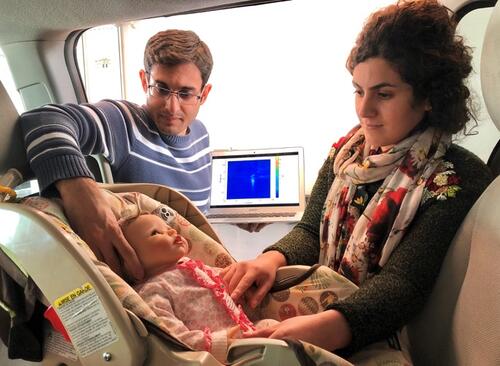
Scientists develop sensor to save children, pets left in vehicles
A small, inexpensive sensor could save lives by triggering an alarm when children or pets are left alone in vehicles.

A small, inexpensive sensor could save lives by triggering an alarm when children or pets are left alone in vehicles.
By Media RelationsThe new device, developed by researchers at the University of Waterloo, combines radar technology with artificial intelligence (AI) to detect unattended children or animals with 100-per-cent accuracy.

Graduate students Mostafa Alizadeh, left, and Hajar Abedi position a doll, modified to simulate breathing, in a minivan during testing of a new sensor.
Small enough to fit in the palm of a hand at just three centimetres in diameter, the device is designed to be attached to a vehicle’s rear-view mirror or mounted on the ceiling.
It sends out radar signals that are reflected back by people, animals and objects in the vehicle. Built-in AI then analyzes the reflected signals.
“It addresses a serious, world-wide problem,” said George Shaker, an engineering professor at Waterloo. his system is so affordable it could become standard equipment in all vehicles.”
Development of the wireless, disc-shaped sensor was funded in part by a major automotive parts manufacturer that is aiming to bring it to market by the end of 2020.
Analysis by the device determines the number of occupants and their locations in a vehicle. That information could be used to set rates for ride-sharing services and toll roads, or to qualify vehicles for car-pool lanes.
Its primary purpose, however, is to detect when a child or pet has been accidentally or deliberately left behind, a scenario that can result in serious harm or death in extremely hot or cold weather.
In such cases, the system would prevent vehicle doors from locking and sound an alarm to alert the driver, passengers and other people in the area that there is a problem.
“Unlike cameras, this device preserves privacy and it doesn’t have any blind spots because radar can penetrate seats, for instance, to determine if there is an infant in a rear-facing car seat,” said Shaker, a cross-appointed professor of electrical and computer engineering, and mechanical and mechatronics engineering.
The low-power device, which runs on a vehicle’s battery, distinguishes between living beings and inanimate objects by detecting subtle breathing movements.
Researchers are now exploring the use of that capability to monitor the vital signs of drivers for indications of fatigue, distraction, impairment, illness or other issues.
Shaker supervised graduate students Mostafa Alizadeh and Hajar Abedi on the research.
A paper on their project, Low-cost low-power in-vehicle occupant detection with mm-wave FMCW radar, was recently presented at an international conference in Montreal.

Engineering master's student Nayeema Nonta (left), one of the three paper authors, and her supervisor, Dr. Sirisha Rambhatla, in a large server room with the computer power needed to develop their new LLM training technique. (University of Waterloo)
Read more
Waterloo researchers develop highly efficient AI training system that paves the way for cheaper, greener “intelligent partners”

Read more
Engineering researchers team up to tackle the plastics pollution problem with microbial innovation and engineering design

Read more
15 University of Waterloo researchers have been named to the annual Highly Cited Researchers™ list for significant contributions to their specific fields of research
The University of Waterloo acknowledges that much of our work takes place on the traditional territory of the Neutral, Anishinaabeg, and Haudenosaunee peoples. Our main campus is situated on the Haldimand Tract, the land granted to the Six Nations that includes six miles on each side of the Grand River. Our active work toward reconciliation takes place across our campuses through research, learning, teaching, and community building, and is co-ordinated within the Office of Indigenous Relations.